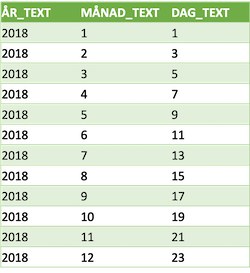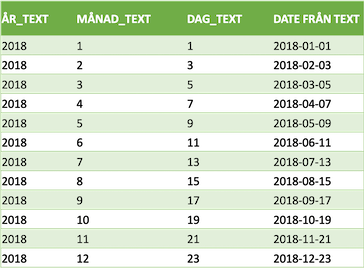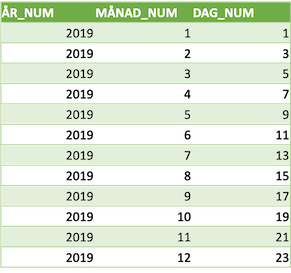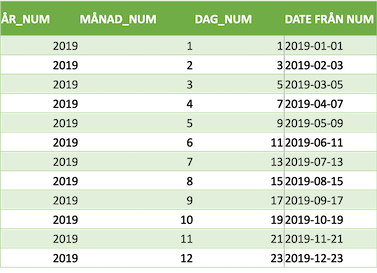Formelspråket som används i Power BI heter DAX - Data Analysis Expressions . Språket utgörs av ett stort antal funktioner med konstanter och operatorer vilka används i formler och uttryck för att beräkna ett eller flera värden. DAX skapar helt enkelt ny information utifrån data som redan finns i din datamodell.
Funktionerna i DAX delar vi in i följande grupper: DATETIME, FILTER, INFO, LOGICAL, MATHTRIG, PARENTCHILD, STATISTICAL, TEXT, TIMEINTELLIGENCE samt OTHER.
DAX Function: DATE
Reference group: DATETIME
Du har kanske redan brottats en del med datumformat i Microsoft Excel och sitter nu med liknande problemställningar i Microsofts BI verktyg Power BI.
I Power BI finns kraftfulla, fördefinierade funktioner som är mycket användbara för att göra beräkningar över tid. För att kunna nyttja dessa funktioner måste man bl.a. ha alla aktuella datumangivelser i korrekta datumformat.
I de fall datum är i annat format, som separerade text eller numeriska fält, behöver de formateras om till korrekt datumformat. Detta gör man med DATE-funktionen. DATE-funktionen hittar du i referensgruppen DATETIME. I exemplen nedan visar vi hur du formaterar text och numeriska värden till ett specifikt datum.
DATE function (DAX)
DATE-funktionen tar heltal som argument och genererar motsvarande datum. Den underliggande data kan till exempel innehålla datum i ett format som inte är känt som ett datum utan som text eller numeriskt. En ny kolumn i datumformat skapas enkelt med syntax enligt nedan.
Syntax: DATE(<year>;<month>; <day>)
Exempel 1.
I exemplet nedan visar vi hur du skapar datumkolumnen ”DATE FRÅN TEXT” utifrån textfälten ÅR_TEXT, MÅNAD_TEXT och DAG_TEXT i Tabell 1.
Tabell 1
I funktionen DATE anger vi tabell och de textfält vi vill använda för att skapa en ny datumkolumn. För att skapa datumkolumnen “DATE FROM TEXT” använder vi följande syntax:
DATE FRÅN TEXT = DATE(’Tabell 1’[ÅR_TEXT]; ’Tabell 1’[MÅNAD_TEXT]; ’Tabell 1’[DAG_TEXT])
Tabell 1 efter att vi har använt ovanstående syntax.

Exempel 2.
I exemplet nedan visar vi hur du skapar datumkolumnen ”DATE FRÅN NUM” utifrån de numeriska fälten ÅR_NUM, MÅNAD_ NUM och DAG_ NUM.
Tabell 2

I funktionen DATE anger vi tabell och de numeriska fält vi vill använda för att skapa en ny datumkolumn. För att skapa datumkolumn “DATE FROM NUM” använder vi följande syntax:
DATE('TABELL 2'[ÅR_NUM];'TABELL 2'[MÅNAD_NUM];'TABELL 2'[DAG_NUM])
Tabell 2 efter att vi har använt ovanstående syntax.

Flera DATETIME funktioner (DAX)
Ovan har du fått exempel på hur du kan använda DATE funktionen för att skapa en datumkolumn. Det finns ytterligare 21 DATETIME-funktioner i Power BI.
Vill du veta mer vilka DATETIME-funktioner som finns i Power BI kan du ladda ner vår Power BI applikation som visar alla DATETIME funktioner.
För att kunna använda Power BI applikationen behöver du ha Power BI Desktop installerad på din dator. Power BI Desktop är gratis och kan laddas ner här, https://powerbi.microsoft.com/sv-se/desktop/.
Om du inte redan har Power BI Desktop installerat och behöver hjälp med detta kan vi naturligtvis hjälpa till.
Håll utkik efter ytterligare blogginlägg på denna site.
